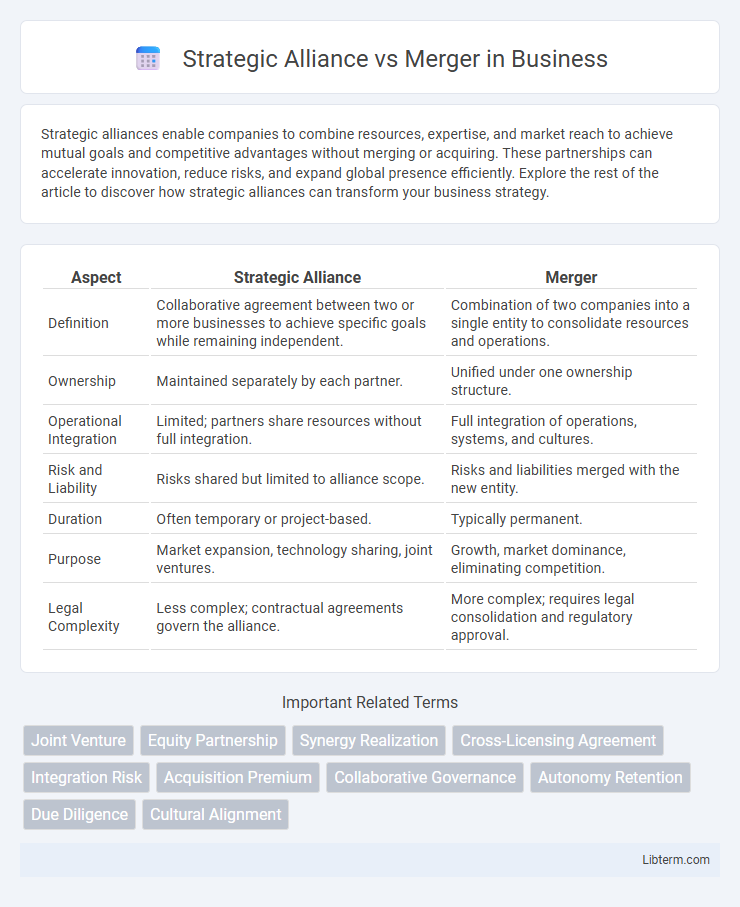Strategic alliances enable companies to combine resources, expertise, and market reach to achieve mutual goals and competitive advantages without merging or acquiring. These partnerships can accelerate innovation, reduce risks, and expand global presence efficiently. Explore the rest of the article to discover how strategic alliances can transform your business strategy.
Table of Comparison
| Aspect | Strategic Alliance | Merger |
|---|---|---|
| Definition | Collaborative agreement between two or more businesses to achieve specific goals while remaining independent. | Combination of two companies into a single entity to consolidate resources and operations. |
| Ownership | Maintained separately by each partner. | Unified under one ownership structure. |
| Operational Integration | Limited; partners share resources without full integration. | Full integration of operations, systems, and cultures. |
| Risk and Liability | Risks shared but limited to alliance scope. | Risks and liabilities merged with the new entity. |
| Duration | Often temporary or project-based. | Typically permanent. |
| Purpose | Market expansion, technology sharing, joint ventures. | Growth, market dominance, eliminating competition. |
| Legal Complexity | Less complex; contractual agreements govern the alliance. | More complex; requires legal consolidation and regulatory approval. |
Introduction to Strategic Alliances and Mergers
Strategic alliances involve collaborative agreements between companies to pursue shared objectives while remaining independent entities, allowing resource sharing and risk mitigation without full integration. Mergers combine two or more companies into a single legal entity, aiming to achieve synergies, expand market share, and enhance competitive advantage through complete operational and financial integration. Both strategies serve growth and expansion goals but differ fundamentally in structure, control, and commitment levels.
Defining Strategic Alliances
Strategic alliances are collaborative agreements between two or more organizations that share resources and expertise while remaining independent entities, aiming to achieve mutual benefits without full integration. Unlike mergers, which combine companies into a single legal entity, strategic alliances allow partners to maintain control over their operations and leverage complementary strengths. These partnerships often focus on specific projects or markets, enabling flexibility and risk-sharing without the complexities of ownership consolidation.
Understanding Mergers
Mergers involve the combination of two or more companies into a single legal entity, aiming to achieve synergies, expand market share, and increase competitive advantage. They often require regulatory approval and involve complex integration of operations, cultures, and financial systems. Understanding mergers is crucial for assessing potential risks, benefits, and long-term value creation in corporate strategy.
Key Differences Between Alliances and Mergers
Strategic alliances involve two or more companies collaborating while remaining independent entities, allowing shared resources and expertise without full integration. Mergers result in the combination of companies into a single entity, leading to unified management, operations, and ownership. Key differences include the level of integration, with alliances maintaining separate legal identities and mergers creating one consolidated company.
Advantages of Strategic Alliances
Strategic alliances offer companies the advantage of resource sharing and combined expertise without the complexities of full integration or ownership transfer seen in mergers. They enable faster market entry and flexibility, allowing each partner to maintain operational independence and reduce financial risk. Access to complementary strengths and global networks fosters innovation and competitive advantage while preserving company culture and autonomy.
Benefits of Mergers
Mergers create significant economies of scale that reduce operational costs and enhance competitive advantage by combining complementary strengths of entities. They facilitate access to new markets and diverse customer bases, accelerating revenue growth and market share expansion. Increased financial resources and shared technological capabilities in mergers lead to improved innovation and long-term sustainability.
Common Challenges in Alliances and Mergers
Common challenges in strategic alliances and mergers include cultural clashes, integration complexities, and misaligned objectives. Both forms face difficulties in establishing clear communication channels and managing stakeholder expectations effectively. Addressing trust issues and balancing control between parties is essential to achieve successful collaboration and synergy realization.
Factors to Consider When Choosing Between Alliance and Merger
When choosing between a strategic alliance and a merger, companies must evaluate factors such as the desired level of control, resource commitment, and long-term objectives. Strategic alliances offer flexibility and lower risk by enabling collaboration without full integration, while mergers require high capital investment and lead to complete organizational unification. Assessing compatibility in corporate culture, financial stability, and regulatory implications also plays a crucial role in the decision-making process.
Real-World Examples: Alliances vs Mergers
Strategic alliances like the Starbucks and PepsiCo partnership enabled both companies to leverage distribution networks without full ownership, maintaining flexibility and shared risk. In contrast, mergers such as the 2018 Walt Disney and 21st Century Fox deal resulted in complete consolidation of assets and operations, driving market share expansion and resource integration. These real-world examples demonstrate that alliances often focus on collaboration benefits without loss of independence, while mergers emphasize full combination for competitive advantage.
Conclusion: Which is Right for Your Business?
Choosing between a strategic alliance and a merger depends on your business goals, resources, and risk tolerance. Strategic alliances offer flexibility, lower financial commitment, and quick market access, ideal for companies seeking collaboration without full integration. Mergers provide deeper consolidation, economies of scale, and strengthened market position, suitable for businesses aiming for long-term growth and competitive advantage.
Strategic Alliance Infographic

 libterm.com
libterm.com